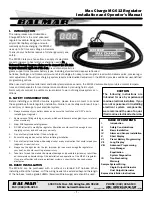
11
1. Introduction
SQ16
8. Changing Accent settings for one track (requires velocity sensitive bass drum)
During steps 6 and 7 of your tour we have learnt how to edit the On/Off track and the Accent track for instrument track
12; both the On/Of track and the Accent track are pattern data. The accent track is responsible for the placement of
accents; and of course now we'd like to know how to set the common velocity values for low and high velocity for the
various tracks of a pattern. Those settings don't belong to the pattern data. Those individual velocity settings are edited
and stored in a Step Set. A pattern then gets assigned a Step Set (the SQ16 contains 16 Step Sets) and the settings of
this Step Set are used for the instrument tracks of the pattern.
Since Pattern 1 is currently using Step Set 1 you need to edit Step Set 1 to change the velocity settings for instrument
track 12 (bass drum).
8.1. Activate the "Step Set Edit" function. The left display reads "I12"; this means all subsequent actions affect the
velocity settings for instrument track 12.
8.2. Press "ACC Low" (step button 2). The right display shows the velocity value used for steps without accent (90). You
ca change this value by pressing the "Up" or "Down" button (step buttons 11 and 12).
8.3. Press "ACC High" (step button 3). The right display shows the velocity value used for steps with accent (115). You
ca change this value by pressing the "Up" or "Down" button (step buttons 11 and 12).
Make the necessary edits to achieve a difference in volume between ACC Low and ACC High.
Activating the Delay function
8.4. Press "ACC Mode" (step button 1). The right display reads "HL". This results in an accented output for Step 3 and
a non-accented output for Step 1.
8.5. Press the "Up" button (step button 11). This changes the mode to "dn". You'll here an echo that starts on Step 3
(accent set) and decreases in volume (from ACC High to ACC Low).
8.6. Press the "Up" button again. This switches to "dr" mode. You'll here an echo that starts on Step 3 (accent set) and
increases in volume (from ACC Low to ACC High).
8.7. Press the "Up" button again. This switches to "drn" mode. You'll here an echo that starts on Step 3 (accent set),
increases in volume (from ACC Low to ACC High) and then decreases in volume (from ACC High to ACC Low).
8.8. Press the "Down" button (step button 12) until mode "dn" is selected. Press "Delay Repeat" (step button 4). The
right display shows the number of repeats. You can change the value using the "Up" or "Down" buttons (step but-
tons 11 and 12). Before continuing with the next example set this value to 4.
8.9. Press "Delay Time" (step button 4). The right display shows the number of steps after which the echo starts. You
can change the value using the "Up" or "Down" buttons (step buttons 11 and 12). Before continuing with the next
example set this value to 4.
You can make individual assignments for Mode, Accent and Delay for each instrument track.
9. Assigning a specific instrument to an instrument track.
This section describes how to assign a different instrument to instrument track 12 (current setting: bass drum).
One instrument track - and hereby all steps of an instrument track - triggers exactly one MIDI note number; this results
in one single drum sound. MIDI note C1 was assigned to Track 12; this is the note number for a bass drum in the GM
drum set.
Assigning note numbers and MIDI channels is done via MIDI Sets. Each pattern gets assigned one of the 16 MIDI Sets
in the SQ16. A MIDI Set contains all the note numbers and MIDI channels for the instrument tracks; those settings are
edited directly in the MIDI Sets. The pattern contains just a pointer to a certain MIDI Set; the instrument tracks use the
MIDI channels and note numbers of the assigned MIDI Set.
Содержание SQ16
Страница 1: ...Owners Manual SQ16 ...












































